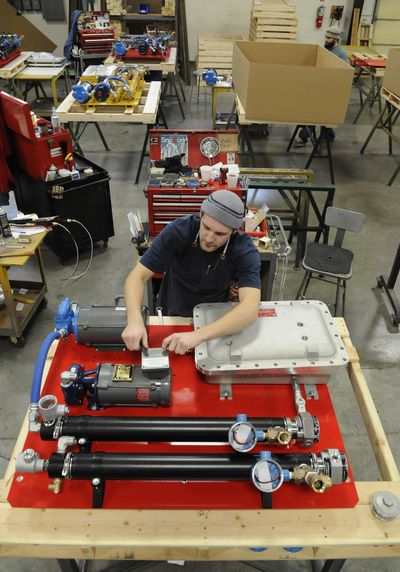Cool hot
A national leader in its market, Spokane Valley’s Kim Hotstart remains little known in its own community

Several years ago, the sales group at Kim Hotstart Manufacturing’s Spokane Valley office knew the onset of winter produced a rash of orders from mining firms, truck manufacturers and large construction companies, all eager to get new or replacement heating units on their valuable equipment.
They all were ordering heaters or engine accessories made in Spokane Valley and designed to ensure their essential machinery could operate in extreme temperatures.
“Now we’re pretty much busy all year long,” says Mike Floyd, communications manager.
“Our customers are now pretty much ordering about the same level all year long.”
By producing high-quality equipment used in a large number of industries, Kim Hotstart has become well-known nationwide, but barely known in its own backyard.
“Our most common question people have is, ‘What do you guys do?’ ” operations manager Jim Randall said.
Kim Hotstart, which opened in 1942 in Spokane, makes heaters and accessories that keep engines from small compressors to train locomotives – warm enough to be started instantly if needed.
Nearly every office or company emergency generator has an accessory piece of equipment likely made by Kim Hotstart. For instance, a hospital is required by law to turn on emergency generators within 10 seconds if power shuts down.
That generator could not turn on if left unheated, Floyd said. The Kim Hotstart system keeps the generator fluids heated between 100 and 120 degrees, allowing immediate startup.
The company, which has about 140 workers at its production site, sells preheaters that range in price from about $30 to $30,000 for units installed in locomotives. Those big units keep a train engine’s coolant and oil warm. Railroads buy them in order to shut down the engine and save fuel. Without the Hotstart warmer, rail locomotive engines are left idling, wasting fuel and polluting the air, Randall said.
“They operate in a niche market,” said Fred McGinn, a sales manager with Cadel, an equipment distributor in Langley, B.C.
“But they know their market well and they are known for making great products.”
Customers using Kim Hotstart products range from ski resorts to the U.S. military.
The next time you use a ski lift at Schweitzer Mountain or 49 Degrees North, you’re getting up the hill on a lift powered by a generator equipped with a heating system from Kim Hotstart.
“And you’ll also find our units in nuclear submarines,” Randall said. “We don’t sell directly to the government, usually. We sell to companies that install the units for the Navy.”
About half of the company’s sales are in heaters for generators that heat both the engine oil and engine body to 100-120 degrees for quick startup.
The rest of the revenue breaks down this way: oil and gas drillers, about 20 percent; railroads, heavy-duty truck manufacturers and large construction equipment, each about 10 percent, Floyd said.
While area manufacturers are bracing for a slowdown and possible layoffs, Randall said the company expects to make money in 2009. Its one year of negative growth occurred in 2002.
In 2003 it generated about $15 million in sales and it’s been growing its bottom line ever since, Floyd said.
Sales this year will reach about $35 million, the company’s best yet. And Randall said 2009 could be in the $37 million range.
To make it through the challenges of a flagging economy, Kim Hotstart managers are using several strategies. They’re introducing company-wide “lean” manufacturing techniques to cut inefficiency.
Also, some key customers have not been significantly hurt yet, Randall said. “While some industries are seeing cuts, others we deal with are not,” including energy companies and mining operations, he said.
Since Kim Hotstart has at least 70 percent of the market, it can pass along to customers higher costs of parts and supplies, Randall said.
Customers come to expect the best quality from the company, he added, which enables Kim Hotstart to raise prices for some of its higher-end products..
That market dominance and ability to set prices hasn’t gone unnoticed by some distributors, especially as those distributors face sales declines.
McGinn at the B.C. distributor Cadel said he would rather Kim Hotstart buy more parts from lower-cost suppliers. That would help offset declines due to the slumping economy.
Randall said offshore suppliers are used when a customer needs products that require parts made only in another country. But Kim Hotstart relies almost entirely on U.S.-made parts, in large part to ensure high quality.
Kim Hotstart has looked at overseas production to cut costs and decided it’s not ready to move jobs offshore.
“Many people realize that option is not the most cost-efficient way to go,” Randall said.
He said offshore production creates longer production lead times, loss of control and higher transportation costs.
“If you don’t do your homework and have a high level of confidence in the (companies you hire), your costs are actually higher in the end.”